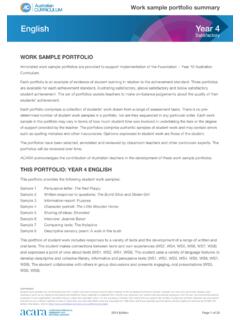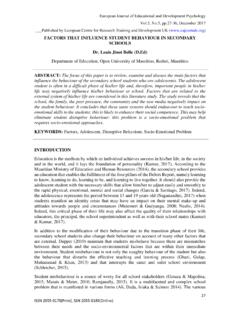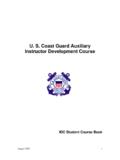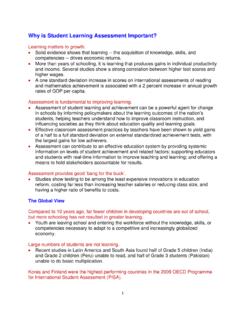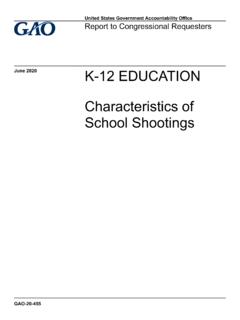Transcription of Personal and Social Capability learning continuum
1 Personal and Social Capability learning continuumSub-elementLevel 1aStudents:Level 1bTypically, by the end of Foundation Year, students:Level 2 Typically, by the end of Year 2, students:Level 3 Typically, by the end of Year 4, students:Level 4 Typically, by the end of Year 6, students:Level 5 Typically, by the end of Year 8, students:Level 6 Typically, by the end of Year 10, students:Self-awareness elementRecognise emotionsrecognise and identify their own emotionsidentify a range of emotions and describe situations that may evoke these emotions compare their emotional responses with those of their peers describe the influence that people, situations and events have on their emotions explain how the appropriateness of emotional responses influences behaviour examine influences on and consequences of their emotional responses in learning .
2 Social and work-related contexts reflect critically on their emotional responses to challenging situations in a wide range of learning , Social and work-related contexts Recognise Personal qualities and achievementsexpress a Personal preferenceidentify their likes and dislikes, needs and wants, and explore what influences theseidentify and describe Personal interests, skills and achievements and explain how these contribute to family and school life describe Personal strengths and challenges and identify skills they wish to develop describe the influence that Personal qualities and strengths have on their learning outcomesmake a realistic assessment of their abilities and achievements.
3 And prioritise areas for improvement assess their strengths and challenges and devise personally appropriate strategies to achieve future success Understand themselves as learners select tasks they can do in different learning contextsidentify their abilities, talents and interests as learners discuss their strengths and weaknesses as learners and identify some learning strategies to assist them identify and describe factors and strategies that assist their learningidentify preferred learning styles and work habits identify and choose a range of learning strategies appropriate to specific tasks and describe work practices that assist their learning evaluate the effectiveness of commonly used learning strategies and work practices and refine these as
4 Required Develop reflective practicerecognise and identify participation in or completion of a taskreflect on their feelings as learners and how their efforts affect skills and achievements reflect on what they have learnt about themselves from a range of experiences at home and school reflect on Personal strengths and achievements, based on self-assessment strategies and teacher feedbackmonitor their progress, seeking and responding to feedback from teachers to assist them in consolidating strengths, addressing weaknesses and fulfilling their potentialpredict the outcomes of Personal and academic challenges by drawing on previous problem-solving and decision-making strategies and feedback from peers and teachers reflect on feedback from peers, teachers and other adults.
5 To analyse Personal characteristics and skill sets that contribute to or limit their Personal and Social capabilityPersonal and Social Capability learning continuumSub-elementLevel 1aStudents:Level 1bTypically, by the end of Foundation Year, students:Level 2 Typically, by the end of Year 2, students:Level 3 Typically, by the end of Year 4, students:Level 4 Typically, by the end of Year 6, students:Level 5 Typically, by the end of Year 8, students:Level 6 Typically, by the end of Year 10, students:Self-management elementExpress emotions appropriatelyrecognise and identify how their emotions influence the way they feel and actexpress their emotions constructively in interactions with others describe ways to express emotions to show awareness of the feelings and needs of others identify and describe strategies to manage and moderate emotions in increasingly unfamiliar situations explain the influence of emotions on behaviour.
6 learning and relationships forecast the consequences of expressing emotions inappropriately and devise measures to regulate behaviour consider control and justify their emotional responses, in expressing their opinions, beliefs, values, questions and choices Develop self-discipline and set goalsmake a choice to participate in a class activityfollow class routines to assist learning set goals in learning and Personal organisation by completing tasks within a given time explain the value of self-discipline and goal-setting in helping them to learn analyse factors that influence ability to self-regulate.
7 Devise and apply strategies to monitor own behaviour and set realistic learning goals select, use and analyse strategies that assist in regulating behaviour and achieving Personal and learning goals critically analyse self-discipline strategies and Personal goals and consider their application in Social and work-related contexts Work independently and show initiativeattempt tasks with support or promptingattempt tasks independently and identify when and from whom help can be sought work independently on routine tasks and experiment with strategies to complete other tasks where
8 Appropriateconsider, select and adopt a range of strategies for working independently and taking initiative assess the value of working independently, and taking initiative to do so where appropriate critique their effectiveness in working independently by identifying enablers and barriers to achieving goals establish Personal priorities, manage resources effectively and demonstrate initiative to achieve Personal goals and learning outcomes Become confident, resilient and adaptableidentify people and situations with which they feel a sense of familiarity or belongingidentify situations that feel safe or unsafe, approaching new situations with confidence undertake and persist with short tasks.
9 Within the limits of Personal safety persist with tasks when faced with challenges and adapt their approach where first attempts are not successful devise strategies and formulate plans to assist in the completion of challenging tasks and the maintenance of Personal safety assess, adapt and modify Personal and safety strategies and plans, and revisit tasks with renewed confidence evaluate, rethink and refine approaches to tasks to take account of unexpected or difficult situations and safety considerations Personal and Social Capability learning continuumSub-elementLevel 1aStudents:Level 1bTypically, by the end of Foundation Year, students:Level 2 Typically, by the end of Year 2, students:Level 3 Typically, by the end of Year 4, students:Level 4 Typically, by the end of Year 6, students:Level 5 Typically, by the end of Year 8, students.
10 Level 6 Typically, by the end of Year 10, students: Social awareness elementAppreciate diverse perspectivesshow an awareness for the feelings, needs and interests of othersacknowledge that people hold many points of view describe similarities and differences in points of view between themselves and people in their communities discuss the value of diverse perspectives and describe a point of view that is different from their own explain how means of communication differ within and between communities and identify the role these play in helping or hindering understanding of others acknowledge the values.



